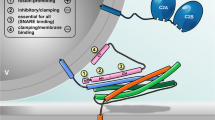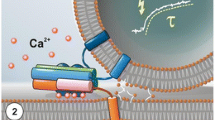Abstract.
Among the multiplicity of roles suggested for proteins of the annexin family, those implicating these proteins in regulated exocytosis remain among the most convincing. Studies in this area of annexin biology have focused on annexin II, which because of its unusually low Ca2+-requirement for phospholipid-binding has many of the requisite properties of a membrane fusogenic Ca2+ sensor. Other annexins are also good candidates for exocytotic mediators, especially annexins I and VII, which have strong vesicle-aggregating activities. In contrast, annexin VI appears to block vesicle aggregation, perhaps acting as a negative regulator of exocytosis. In this review, we consider the evidence for and against annexins having functions in the secretory pathway.
Similar content being viewed by others
Author information
Authors and Affiliations
Rights and permissions
About this article
Cite this article
Donnelly, S., Moss, S. Annexins in the secretory pathway. CMLS, Cell. mol. life sci. 53, 533–538 (1997). https://doi.org/10.1007/s000180050068
Issue Date:
DOI: https://doi.org/10.1007/s000180050068




